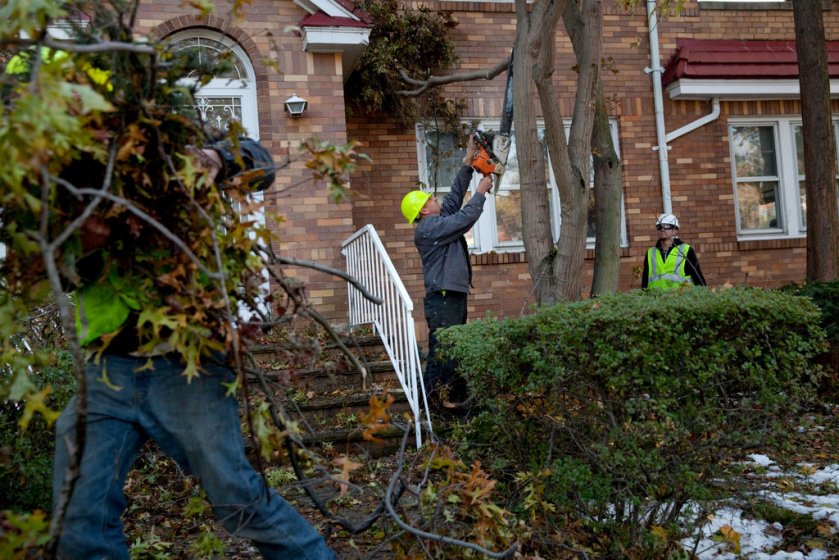It’s one of the signals of summer – the weathermen announce that it’s hurricane season. To skeptics, saying that Hurricane Sandy was caused by climate change, would be considered ridiculous. But, Sandy’s consequences are a clear sign of the changing climate and it could be just the first of many severe acts of nature in the future. The consequences of storms like those could be disastrous for New York and any other areas affected.
The majority of Atlantic hurricanes head into the ocean and dissipate, but Sandy followed a different path. It took a left turn and ran straight into NYC. This is not necessarily directly caused by climate change, but global change could create increases in certain extreme weather events. The IPCC (Intergovernmental Panel on Climate Change) states in their Summary for Policy Makers (2013) that there will be an increase in near-storm precipitation in the future, but there is also a low chance that overall tropical cyclone frequency would decrease. This intensification of the hydrologic cycle occurs because greenhouse gasses warm the atmosphere and make evaporation and precipitation occur more forcefully. These predications also say that there could be an increase in the number of intense hurricanes.
Even with these predictions stating that there might be a decrease in storms, future hurricanes will have an even worse effect than they used to because the seas will swell, causing an increase in storm surges. In Adam Sobel’s 2014 book Storm Surge: Hurricane Sandy, Our Changing Climate, and Extreme Weather of the Past and Future Sobel says that because of the increase in greenhouse gases, the planet could warm and make land ice melt more, thus swelling the ocean. This means that future hurricanes could have even worse flooding effects because of the rising sea level.
Sandy had many disastrous consequences for New York. New York is in a generally low-lying area. When New Orleans was hit with Katrina, the topography proved to be one of the biggest causes of destruction. With almost half the land below sea level, hurricane floods created standing pools of water, destroying many parts of the city. The low-lying areas in New York faced similar problems during Hurricane Sandy and will be problematic in the future as well. Subway tunnels flooded, as did all the automobile tunnels in Manhattan, except for the Lincoln tunnel. West Harlem Waterfront Park was submerged; Coney Island, Brighton Beach, most of Jamaica Bay, the barrier islands of Brooklyn and Queens, and many neighborhoods in Staten Island were all completely flooded (Sobel 2014). The rising sea levels caused by climate change could make the next storm to hit New York even worse than Sandy. The sea level around New York City has already risen a foot during the past hundred years and that number will grow as the planet continues to warm (Sobel 2014).
During the storm 3,444 trees fell into city streets. 3,403 limbs fell down and 1,577 branches were left hanging (Foderaro 2012). This reflects a great loss to the city’s green landscape, but that wasn’t the only effect. The salt water that flooded the city during the storm is believed to be the cause of 10,000 dead or declining trees all over New York (Langfield 2015). The city plans to plant more salt tolerant species to replace these trees, which will hopefully save the plants in the future.

One final effect of Hurricane Sandy is how it has impacted the parks in New York City. Three years after the storm, Inwood Hill Nature Center in Manhattan, Taafle Playground in Brooklyn, and Wolfe’s Pond Park in Staten Island all remain closed due to the effects of Hurricane Sandy. As will be mentioned in my blog post about Jamaica Bay, the West Pond loop trail was rendered impassable by the storm and still remains so.
Climate change will cause storms to be even less predictable than they already are and will make them produce even more destruction than previously seen. Hurricane Sandy is a perfect example of what will happen. New York must take up measures to protect its resources from both the rising sea levels and the damage that will be caused by extreme weather events. In the next science blogs I will look at three different measures that could be taken to counteract these effects: barriers, beach nourishment, and retreat.
Bibliography:
Brenner, M. 2015. Understanding the effects of Hurricane Sandy on Atlantic Coast tidal marshes, wildlife. Hurricane Sandy Recovery. https://www.doi.gov/hurricanesandy/understanding-effects-hurricane-sandy-tidal-marshes-wildlife
Environmental Defense Fund. 2013. Sandy Success Stories: New York, New Jersey June 2013. Environmental Defense Fund. https://www.edf.org/sites/default/files/sites/default/files/content/SandySuccessStories_June2013.pdf
Foderaro, L. W. 2012. Storm Inflicted a Beating on City Trees. The New York Times. http://www.nytimes.com/2012/11/12/nyregion/hurricane-sandy-inflicted-a-beating-on-new-york-city-trees.html?_r=0
IPCC, 2013: Summary for Policymakers. In: Climate Change 2013: The Physical Science Basis. Contribution of Working Group I to the Fifth Assessment Report of the Intergovernmental Panel on Climate Change [Stocker, T.F., D. Qin, G.-K. Plattner, M. Tignor, S. K. Allen, J. Boschung, A. Nauels, Y. Xia, V. Bex and P.M. Midgley (eds.)]. Cambridge University Press, Cambridge, United Kingdom and New York, NY, USA.
Langfield, A. 2015. New York City still feeling the wrath of Superstorm Sandy. CBS Money Watch. http://www.cbsnews.com/news/new-york-city-still-feeling-the-wrath-of-superstorm-sandy/
Long Island Press. 2014. Sandy 2 Years Later: Winners and Losers on Long Island. Long Island Press. https://www.longislandpress.com/2014/10/29/sandy-2-years-later-winners-and-losers-on-long-island/
NYC Parks Department. 2016. Notices: Park and Facility closures. NYC Parks Department. https://www.nycgovparks.org/news/notices
Sobel, A. 2014. Storm Surge: Hurricane Sandy, Our Changing Climate, and Extreme Weather of the Past and Future. HarperCollins. New York, New York, USA.

One thought on “Hurricane Sandy”